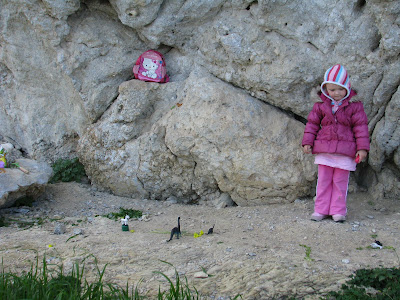
This past weekend I caught a flight afterschool on Friday to Lefkosa of Northern Cyprus to visit my friends whom I used to climb with my first year in Ankara. It was just a quick weekend getaway, but a great chance to get a dose of spring, climbing, and friends I hadn't seen in two years. I had met Mark, Annie, and their little girl, Annalisa, in Ankara; they lived above me in my apartment building. Mark was a professor at Bilkent, and Annie and I shared yoga and climbing.


Now they live in Kyrenia, 20 minutes away from a great limestone crag called Gargasuyu. It overlooks the Mediterranean, and on a clear day such as we had on Saturday, you can look out across the Mediterranean Sea and make out the mainland of Turkey, some 300 miles away. I tried to adjust the exposure on my camera to catch this. Can you see it?

The climbing felt great. I feel really strong after a winter of training at the local bouldering gym. This was the best transition into climbing outdoors I've ever experienced.




This is their little girl, Annalisa, now almost three, who is still totally afraid of me. I wasn't allowed to touch any of her toys :( Luckily, I brought my own (climbing shoes and harness).



On Sunday, we were all packed up to head to the crag for day #2 of climbing when it started to rain. So instead we headed to the capital city, Nicosia (known as Lefkosa to Turks), for a wander-about.

The old city is in the shape of a mandala. It was called Ledra from 600BC onwards. It was controlled by the Venetians in the 1400s, then the Ottomans in the 1500s. (This IS the place where Shakespeare's Othello and Desdemona met their demise, the Venetian-Ottoman battles for Cyprus bringing them to the island). Then from 1878-1960, the Brits had control. Since the city experienced extreme violence around the time the Cypriots gained control from the Brits, a U.N. Buffer Zone was put into place. Nicosia is the world's last divided city, divided down the middle by a UN sanctioned Buffer Zone called the Green Line. The tension between the Greek and Turkish Cypriots is still palpable. Also, many Turkish Cypriots whose families have been present on the island since the Ottoman Empire want sovereignity from mainland Turkey's government. Mentioning you're from Ankara is not a great thing to say to
anyone here. There was a children's book in a museum shop we wandered into that sums it up: "Cyprus: The Island That Everyone Wants."
I think it's most important to note that this
is the island where Aphrodite arose from the seafoam.
We took a walk in the rain through this Buffer Zone, and experienced both the Turkish and Greek-occupied parts of Nicosia. The Turkish side had an interesting medieval cathedral-turned-mosque.




The Turkish side also had many rundown shops, mostly men sitting at cafes, untidy children wandering the streets, much the scene of any poor village in Turkey. As we crossed the Green Line, it instantly felt like we were in Europe, with boutique shops, Starbucks, and a heterogenous mix of people.
No pictures of the Greek side. I'd put my camera away upon crossing the Green Line because I remembered getting reprimanded last time I tried to take pictures in this buffer zone, when I crossed it two years ago heading to Paphos for Spring Break with Stacy, Liam, and Gabe. So you'll just have to trust me that it looked and felt just like Europe :)
Shortly thereafter, I caught a Sunday afternoon flight back to Ankara. And now I have the climbing bug
and the spring bug.







































